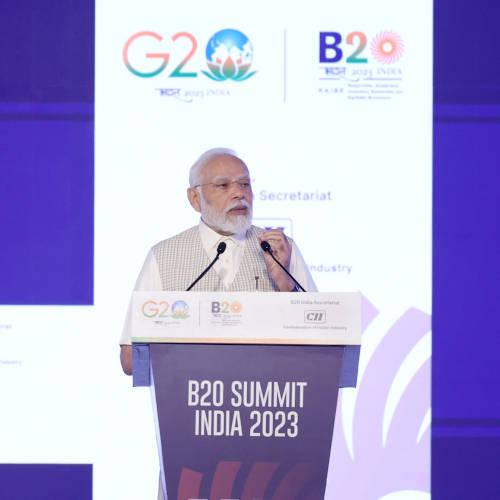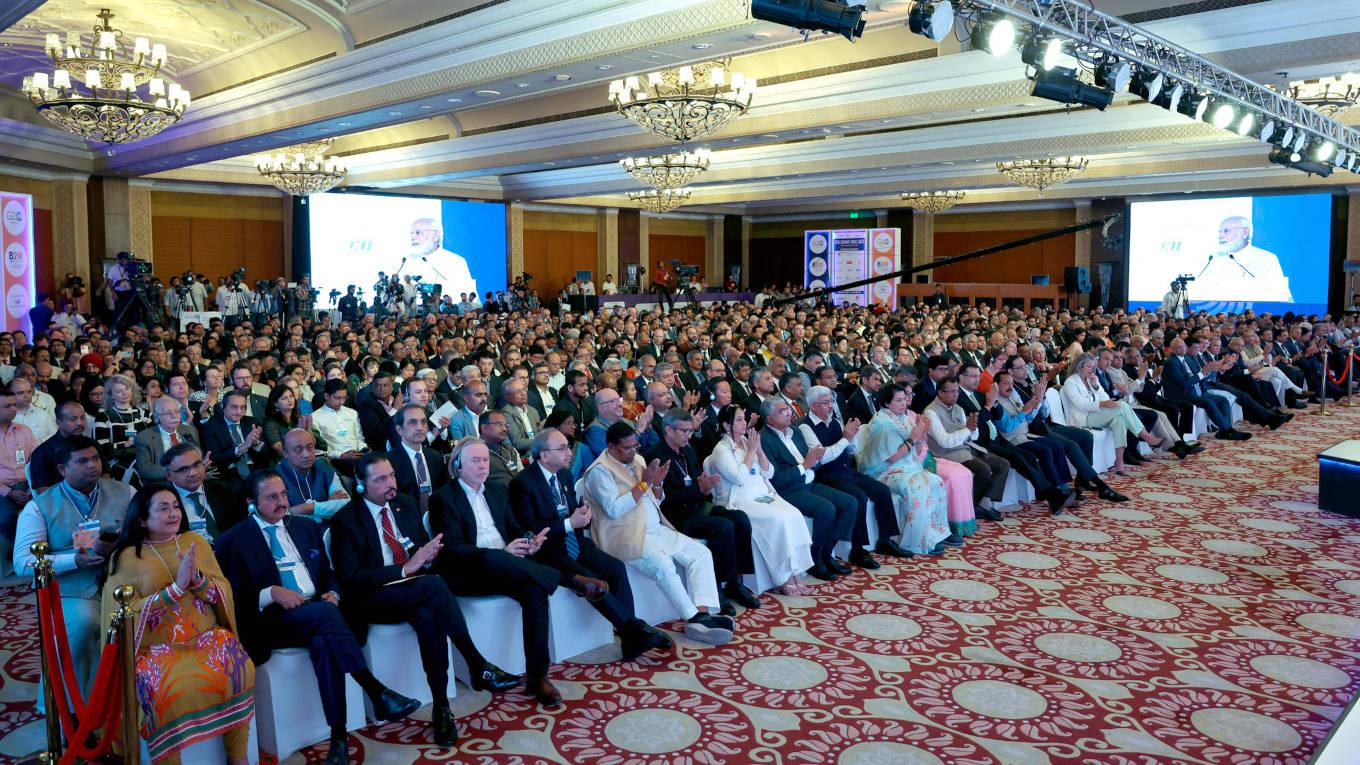-
Fundamentally, India is going from an offline, informal, low productivity, multiple set of micro-economies to a single online, formal, high-productivity mega economy – a trend that will continue over the next 20 years
Nandan Nilekani, chairman & co-founder, Infosys and founding chairman, UIDAI
The prime minister’s speech also contained a strong pitch for giving more prominence to the global South and creating a more equitable eco-system for countries which have peripheral existence in the global economy. Earlier in the conference, External Affairs Minister S. Jaishankar had made quite an assertive speech on this front, saying that the integration of global south is a pertinent issue now, which can’t be ignored any further. “Their contribution very often was to provide resources for manufacturing elsewhere,” he said. “They not only didn’t reap the full benefits of economic change, but often ended up saddled with unviable debts emanating from opaque initiatives”.
“There was a passionate plea by India, especially to the developed world, that weaker nations must be integrated more holistically in the global economic order,” says Siraj Chudhary. “This strategic stance made it clear that India is trying to take leadership positioning of the global south”. CII president R. Dinesh told Business India after the meet: “The G-20 forum, under India’s presidency, has sought to bring countries together on issues that could form a part of the common agenda of action for G20 members. In this endeavour, the government exhibited strong solidarity with the partners of the Global South and demonstrated its commitment to share its developmental experience and progress with G-20 counterparts”.
Hard-selling growth story
Some of the invitees to the event vouch that Global South leadership positioning bid was evidently part of the larger pitch of the government to send the message that India’s moment at the global economic stage has arrived and it is truly in the front row now. That India has managed to successfully ward off growth pressures post Corona, a common dampener for other big economies, was a point which was repeatedly emphasised at the grand show by top functionaries.
Finance Minister Nirmala Sitharaman led the charge on this front, when she strongly claimed: “The country has emerged as the fastest growing economy in a vulnerable world,” adding that sustaining global economic recovery has emerged as a major challenge at a time when the world is passing through the aftermath of the devastation caused by Covid-19 and its spill-over effects.
She further assured the global business leaders that India would continue to perform well owing to a slew of economic reforms implemented over the past nine years to improve physical, digital, and social infrastructure. The steps such as National Infrastructure Pipeline, PM Gati Shakti, National Monetisation Pipeline, etc, have been commendable initiatives to boost infrastructure development, she maintained, while adding that 33 per cent rise in public capex, which has led to the crowding in of private investment, has put India on the sustained growth path.
On the international trade front where India is now more prominently placed than ever before (also partially benefitting from China plus one strategy of the developed countries post-Corona), she emphasised that a series of new Free Trade Agreements (FTAs) are in the making, which will redefine India’s global trade positioning. “The FTA agreement with the UK is closing in for a final call, which could be concluded by the year end. The UK would be a threshold for the EU, EFTA and the Nordic countries,” she said.
-

Modi: creating a more equitable ecosystem for countries
Other senior government functionaries did not miss the opportunity in underlining that Indian economy is on a move. Piyush Goyal, Union minister for commerce & industry, batted for mainstreaming of MSMEs calling them ‘true gems’, which are significantly contributing to the economy. Dharmendra Pradhan, minister for education & skill development, focussed on India’s edge in technology and creation of a robust start-up system.
Technology sector stalwart Nandan Nilekani, chairman & co-founder, Infosys and founding chairman, UIDAI (Aadhar), was explicit in explaining how India will be harnessing its technological advantage in the coming decades. “Fundamentally, India is going from an offline, informal, low productivity, multiple set of micro-economies to a single online, formal, high-productivity mega economy – a trend that will continue over the next 20 years. And this has been enabled by new approach to solving society’s problem, through digital public infrastructure (DPI), which essentially enhances the ability of the country to use digital technology at population scale to transform society,” said he.
Brad Smith, president & vice-chairman, Microsoft, and a key figure in the meet concurred with the assumption that India is well-poised to derive further advantage from technological upgradation. “The demographic diversity in India is extraordinary,” observed Smith. “In some ways, generative AI is more powerful in a country that speaks many languages, because it is such a powerful tool that it can help people communicate across different languages.”
Buying the India story
The moot question is: did India’s hard-selling of its growth story go down well with over 1,500 delegates from 55 countries? Responses coming from eminent quarters, prima facie, confirmed that India’s subtle assertion was not exactly perceived as an over-the-top act. “There is a lot of optimism in India, which is also the basis of India’s presidency of G20,” commented Borge Brende, president, World Economic Forum (WEF). “India has been the fastest growing economy for three years in a row, in the middle of sluggish global growth. India will be the third largest economy in the world in a few years, a $10 trillion economy in a decade and larger than Germany and Japan in a few years. It is important for India to continue reforms, build better infrastructure and invest in education”.
Emphasised Francisco Gomes Neto, president & CEO, Embraer, Brazil: “India has a competitive labour cost, availability of engineering, design and technical expertise. There is a good opportunity of collaboration for the space science industry”. Raj Subramaniam, president & CEO, FedEx (USA) had a somewhat guarded response, which underlined that gaining in efficiency factor would be key for India even as it has shown remarkable resilience to global economic hurdles in the recent years. “This can be done with the help of technology and making the supply chains smarter,” he said. “Diversification of supply chains is quite nuanced and complicated. There is opportunity to increase global manufacturing in India, further reducing the cost of logistics due to the benefits of scale”.
According to R. Dinesh, president, CII, the apex industry association, which spearheaded the grand show, the event was a grand success with a host of encouraging outcomes, which will have long-term implication for the global economy. “The seven task forces and two action councils formed under the aegis of B20, formulated 54 recommendations and 172 policy enablers, intended for consideration by the G20 governments,” Dinesh informed.
-
The seven task forces and two action councils formed under the aegis of B20, formulated 54 recommendations and 172 policy enablers, intended for consideration by the G20 governments
R. Dinesh, president, CII
“These recommendations encompass crucial priority areas, including financing for global economic recovery; inclusive global value chains; financial inclusion; digital transformation; technology, innovation and R&D; the future of work, skilling and mobility; and energy and climate change, as well as environmental, social and governance aspects and strengthening the integration of Africa into the global economy”.
For the effective implementation, the summit agreed on a set of broader mechanisms, which include: the institutionalisation of a ‘Global B20 Institute,’ as an evangelist; ‘Financing decarbonisation’; establishment of Global SDG Acceleration Fund (GSAF) and creation of a Compendium of Innovation Projects from India and other G20 economies.
But, even as the grand show saw Indian government putting its best foot forward in announcing arrival of the country’s moment at the global stage and the claim was conveniently bought in some quarters, some murmuring notes did emerge pertaining to the proposition of India maintaining a high growth rate trajectory (7 per cent plus) in the medium-to-long-term, now that its GDP has a sizeable base of over $3.5 trillion. The broader point was: will India manage to emulate Chinese example of sustaining high growth rate for a considerable period even with an expanding base?
The response, no doubt, will emerge in the coming years, but as CII president asserts, there are rock solid positive enablers to ensure that the Indian economy’s high growth story remains intact in the foreseeable future. “The country has the potential to sustain the decent growth trajectory and is poised to achieve 7 per cent growth over the next decade as the country’s performance is backed by robust macro-economic fundamentals, a distinct demographic advantage, a burgeoning middle class with strong purchasing power and, above all, the government’s policy to reform, perform and transform and focus on ease of doing business, along with reducing the cost of it, which has provided a positive environment, conducive for trade and industry to blossom,” says Dinesh.
Incidentally, the latest edition of World Economic Outlook, released by the IMF around July end, gives credence to the optimism on India, at least in the near-to-probably-medium term. The multilateral agency has projected a growth rate of 6.1 per cent for India in 2023, which is a 0.2 percentage point upward revision, compared with the April projection. And this would be a sparkling performance, considering a staggering a 0.5 per cent drop in global economy’s growth projection – from 3.5 per cent to 3 per cent – in 2023 and 2024.



































